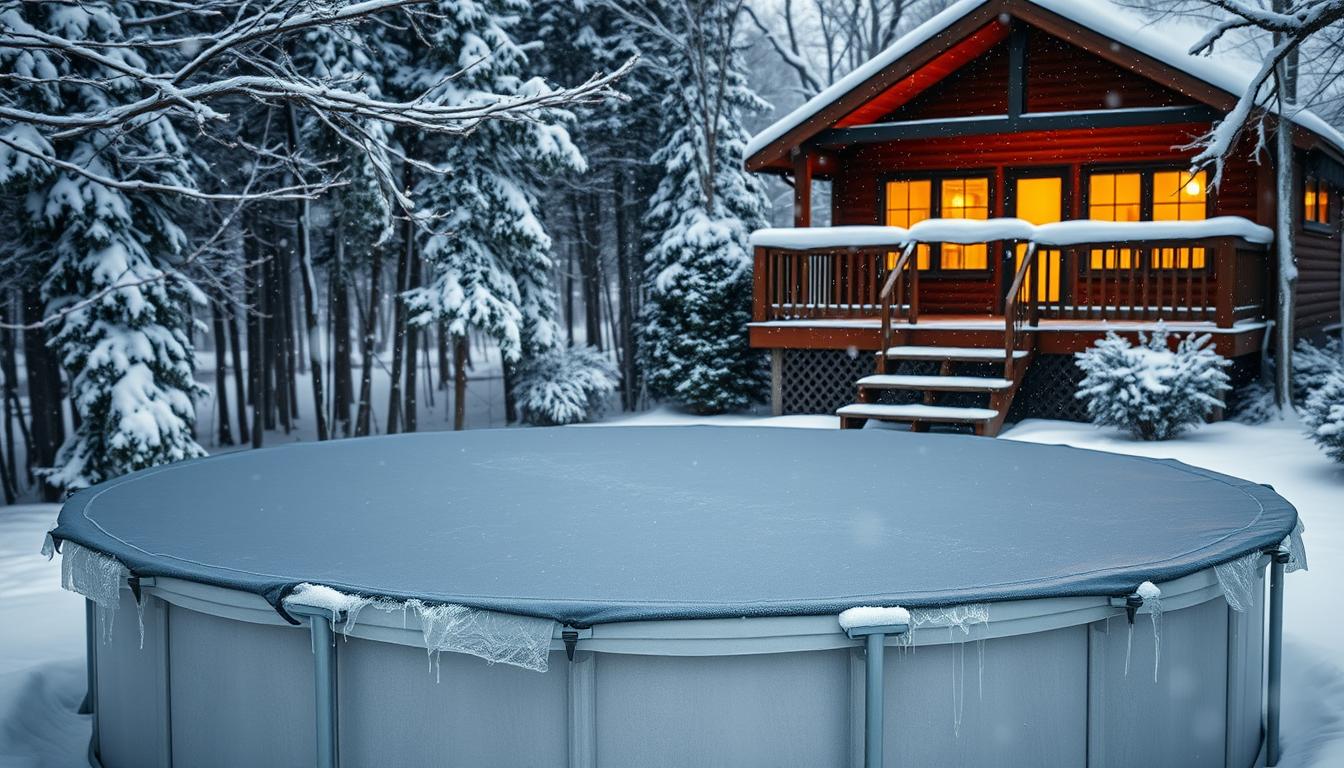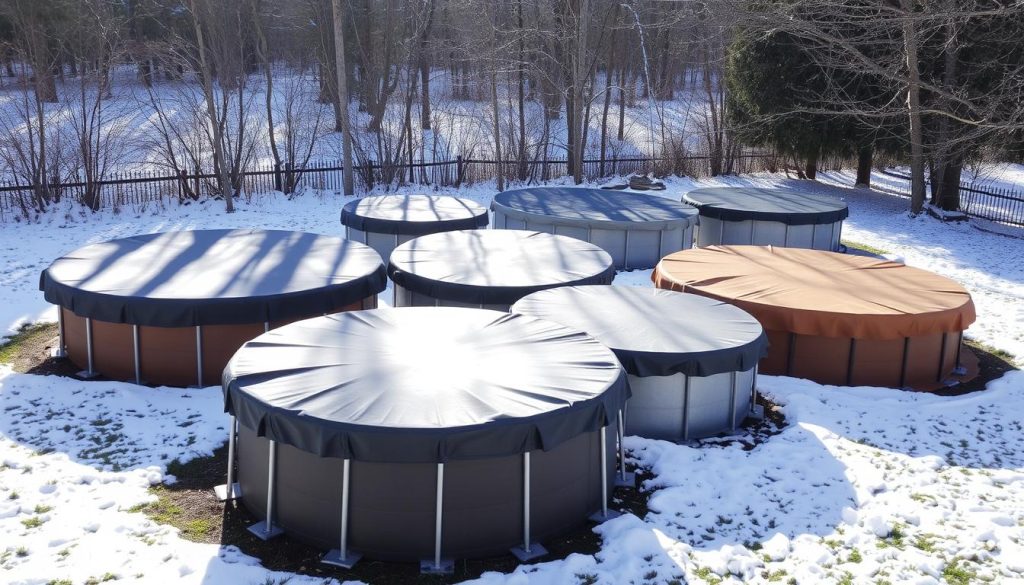
Fall is here, and it’s time to think about winterizing above ground pools. Our neighbors learned this the hard way last year. They didn’t cover their pool before the first freeze, causing serious damage.
Don’t let this happen to you! Proper pool winterizing can protect your backyard oasis through the cold months. It’s quick, easy, and safeguards your investment.
Winterizing an above-ground pool prevents damage to the frame, liner, pipes, and equipment. It also stops algae growth, keeps the pool clean, and deters pests. With the right pool closing supplies, you’ll be ready for next season’s fun.
Timing is crucial for successful above ground pool winterization. Aim to winterize your above-ground pool in mid-October or when water temperature stays below 65°F. Closing too early can weaken winterizing chemicals.
Winter pool covers are vital for winter pool maintenance. Let’s explore how to pick and use the right cover for pool closing.
Importance of Winterizing Your Above Ground Pool
Winterizing your above ground pool protects your investment and keeps it in top shape. It shields your pool from potential damage during harsh winter months. This preparation makes spring opening much easier.
Protecting Your Investment
Your above ground pool is a significant investment that needs protection from winter elements. Neglecting winterization can lead to costly repairs and irreversible damage.
Draining the pool water can cause problems in any season. The liner may shrink beyond repair without water’s weight and outward force.
Removing water from an above ground pool for just a couple of days can cause the walls to sag inward or outward, potentially disfiguring them permanently.
Preventing Damage from Harsh Winter Elements
Winter can be tough on your above ground pool without proper winterization. Freezing temperatures can expand water in pool lines and equipment, cracking pipes and damaging components.
Winterizing steps like draining water lines, disconnecting equipment, and insulating pipes can prevent costly freeze damage.
| Winterizing Step | Importance |
|---|---|
| Choosing the Right Cover | Selecting a weather-resistant pool cover that securely fits over the entire pool is essential for protection during winter months. |
| Secure the Cover | Ensuring that the pool cover is tightly secured is important to prevent it from blowing off during strong winds. |
| Draining Pool Water Lines | Draining all pool water lines, including the skimmer, return lines, and heater, is crucial to prevent freezing and cracking of the pipes. |
| Disconnecting and Draining Pool Equipment | Proper maintenance involves disconnecting and draining the pool pump, filter, and other equipment that holds water to prevent damage during winter. |
Ensuring Easy Pool Opening in Spring
Winterizing your pool makes spring opening much easier. Cleaning, balancing water chemistry, and covering properly before winter reduce spring maintenance work.
One winter without water can cause irreversible damage to above ground pool walls and tracks. Develop an end-of-season closing process to prevent draining and structural damage.
Prioritize winter pool protection to keep your above ground pool enjoyable for years to come.
Preparing Your Pool for Winter
It’s time to winterize your pool when temperatures drop below 65°F. Proper preparation protects your investment and prevents damage. Let’s explore the key steps for winterizing your above ground pool.
Balancing Water Chemistry
Balance your pool’s water chemistry before closing it for winter. Add a stain and scale remover two weeks prior to winterizing. Treat the water with a phosphate remover if needed in the final week.
Aim for these levels: Alkalinity (80-120 ppm), pH (7.4-7.6), and Calcium Hardness (200-400 ppm). This prevents corrosion, scaling, and algae growth during winter.
- Alkalinity: 80-120 ppm
- pH: 7.4-7.6
- Calcium Hardness: 200-400 ppm
Cleaning and Removing Accessories
Clean your pool thoroughly to prevent stains and algae growth. Skim the surface, brush the walls and floor, and vacuum the entire pool.
Remove all accessories from the pool. Clean and store them in a dry place to avoid damage.
- Ladders
- Toys
- Filtration equipment
- Skimmer baskets
- Return fittings
Lowering Water Level
Lower the pool’s water level to 4-6 inches below the skimmer. Use a submersible pump or siphon to drain the water.
Add pool shock, chlorine, and algaecide according to product instructions. This keeps the water clear and algae-free throughout winter.
| Chemical | Recommended Level |
|---|---|
| Pool Shock | 1 lb per 10,000 gallons |
| Chlorine | 1-3 ppm |
| Algaecide | Follow product instructions |
These steps will protect your above ground pool during winter. Next, we’ll discuss how to properly cover your pool for optimal protection.
How to Cover Above Ground Pool for Winter
Winter pool preparation involves proper covering to protect it during cold months. Choosing the right cover, installing air pillows, and securing it are key steps. Let’s explore these crucial aspects of winterizing your above ground pool.

Choosing the Right Winter Pool Cover
Select a cover designed for your pool’s size and shape. Avoid using tarps as they offer inadequate protection. Look for sturdy polyethylene or polypropylene covers that resist tears and punctures.
Ensure the cover has bonded seams to prevent leaks. This feature is crucial for maintaining the pool’s integrity throughout winter.
| Pool Cover Material | Estimated Cost |
|---|---|
| Polyethylene | $75 – $200 |
| Polypropylene | $100 – $300+ |
Installing Air Pillows or Foam Floats
Install a taut yet flexible air pillow or foam float to protect against winter freezing damage. Choose one sized for your pool and secure it to the floor using anchors.
Ensure even inflation of chambers to absorb pressure effectively. Air pillows for above-ground pools typically cost between $10 and $30.
Pro tip: Store pool chemicals in a cool, dry place away from freezing temperatures.
Securing the Cover to the Pool Frame
With help, center the winter pool cover across the entire surface. Secure it tightly to the frame using clips, cable, or a winch.
For windy areas, use perimeter weights or water bags for added stability. This extra step ensures protection throughout winter.
- Clips
- Cable
- Winch
Maintaining Your Pool During Winter Months
Winter pool care is vital for keeping your above ground pool in top shape. Pool cover maintenance is a key part of this process. Check your cover’s clips, tension, and drainage monthly to prevent issues.
Clear snow from the cover with a brush or leaf net to avoid damage. This helps protect the cover from overloading and potential failure.
Monitor water levels every few weeks and top off as needed. This ensures the cover stays in place and protects the pool’s structure.
Patch small cover punctures quickly to prevent them from getting worse. Add algaecide mid-winter to stop algae growth in your pool.
Test and adjust your pool’s water chemistry regularly. Check pH, alkalinity, and calcium hardness levels. Make changes as needed to prevent conditions that encourage algae growth.
Keeping up with these tasks will help your pool stay in great shape all winter. This makes opening your pool in spring much easier.







